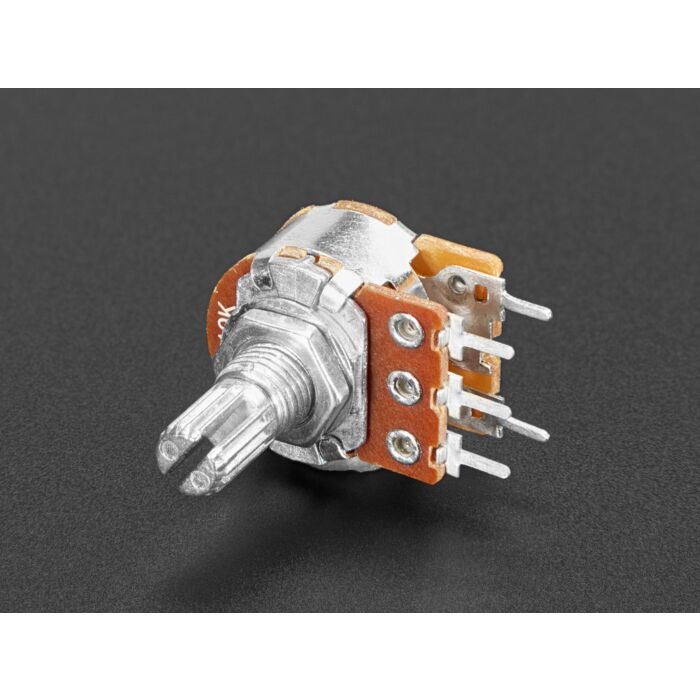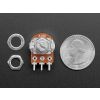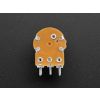Panel Mount 10K Log Potentiometer w/ On-Off Switch - 10K Log w/ Switch
Available with a lead time
Expect dispatch between Jan 02 and Jan 07
Quantity Discounts:
- 10+ $3.13 (exc GST)
- 50+ $3.06 (exc GST)
This potentiometer is a two-in-one: it's a log taper 10K ohm potentiometer, with a grippy shaft and it comes with an on-off switch. It's smooth and easy to turn, but not so loose that it will shift on its own. Adafruit like this one because the legs are 0.2" apart with pin-points, so you can plug it into a perfboard. Note the spacing on the switch/pot pins is 0.2" so it wont work in a solderless breadboard as nicely, unless you bend the switch pins out of the way. Once you're done prototyping, you can drill a hole into your project box and mount the potentiometer that way.
Potentiometers, or "pots" to electronics enthusiasts, are differentiated by how quickly their resistance changes. In linear pots, the amount of resistance changes in a direct pattern. If you turn or slide it halfway, its resistance will be halfway between its minimum and maximum settings. That's ideal for controlling lights or a fan, but not necessarily for audio controls.
Volume controls have to cater to the human ear, which isn't linear. Instead, logarithmic pots like this one increase their resistance on a curve. At the halfway point volume will still be moderate, but it will increase sharply as you keep turning up the volume. This corresponds to how the human ear hears. Using a log pot therefore gives the effect that a setting of full volume on the control sounds twice as loud as a setting of half volume. A linear pot used as a volume control would give large apparent changes in loudness at low volume settings, with little apparent change over the rest of the control's range.
The built-in switch makes it perfect for audio projects where you want to control both power and volume of a monophonic signal.
Once you're done prototyping, you can drill a hole into your project box and mount the potentiometer using the included washer and hex nut. We've got plenty of matching T18-splined knobs that you can pair up.
Technical Details
Exact shipping can be calculated on the view cart page (no login required).
Products that weigh more than 0.5 KG may cost more than what's shown (for example, test equipment, machines, >500mL liquids, etc).
We deliver Australia-wide with these options (depends on the final destination - you can get a quote on the view cart page):
- $3+ for Stamped Mail (typically 10+ business days, not tracked, only available on selected small items)
- $7+ for Standard Post (typically 6+ business days, tracked)
- $11+ for Express Post (typically 2+ business days, tracked)
- Pickup - Free! Only available to customers who live in the Newcastle region (must order online and only pickup after we email to notify you the order is ready). Orders placed after 2PM may not be ready until the following business day.
Non-metro addresses in WA, NT, SA & TAS can take 2+ days in addition to the above information.
Some batteries (such as LiPo) can't be shipped by Air. During checkout, Express Post and International Methods will not be an option if you have that type of battery in your shopping cart.
International Orders - the following rates are for New Zealand and will vary for other countries:
- $12+ for Pack and Track (3+ days, tracked)
- $16+ for Express International (2-5 days, tracked)
If you order lots of gear, the postage amount will increase based on the weight of your order.
Our physical address (here's a PDF which includes other key business details):
40 Aruma Place
Cardiff
NSW, 2285
Australia
Take a look at our customer service page if you have other questions such as "do we do purchase orders" (yes!) or "are prices GST inclusive" (yes they are!). We're here to help - get in touch with us to talk shop.
Have a product question? We're here to help!
Guides
The Maker Revolution
Potentiometers and the Arduino Uno
Projects
Potentiometer Position Monitor
Makers love reviews as much as you do, please follow this link to review the products you have purchased.

















Product Comments